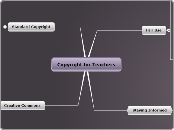Copyright for Teachers
Fair Use
An exception to the exclusive right granted by copyright law to the author of a creative work. A doctrine in U.S. copyright law that allows limited use of copyrighted material without getting permission from the author.
Criteria for Fair Use
The purpose and character of the use, including whether it is for commercial use or for nonprofit educational purposes.
The nature of the copyrighted work.
The amount and substantiality of the portion used in relation to the copyright-protected work as a whole.
The effect of the use on the potential market for or value of the copyright-protected work.
Why should teachers care?
It is important for teachers to understand Fair Use when using multimedia within their classroom. Knowing what pictures, videos, etc. is permitted to be used without getting permission from the author is an important aspect to a teacher's career.
For example, a teacher should know the rights of a picture when using it in a classroom presentation.
Staying Informed
Staying informed on copyright laws is important. From time to time, a teacher should look at copyright websites, such as www.copyright.com, to stay informed on new laws and changes. Also, visiting fellow teacher's blogs and sites may be helpful to keep up with new copyright information.
Standard Copyright
A set of exclusive right granted to the author of an original work, including the right to copy, distribute and adapt the work.
Creative Commons
A non-profit organization that provides free copyright licenses to the public. These licenses allow the authors to decide which rights they reserve and which rights they waive for others to use or modify their work.
